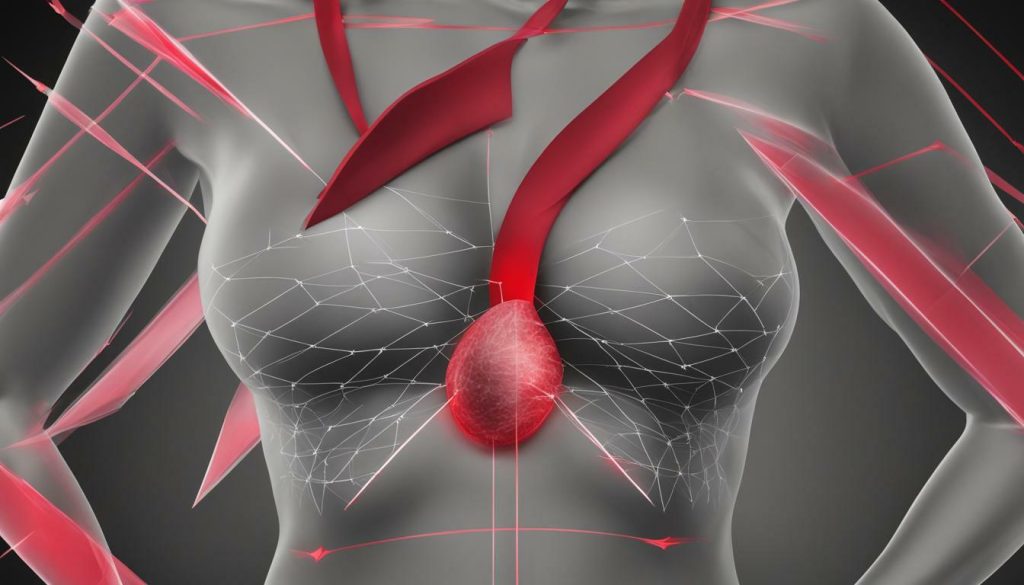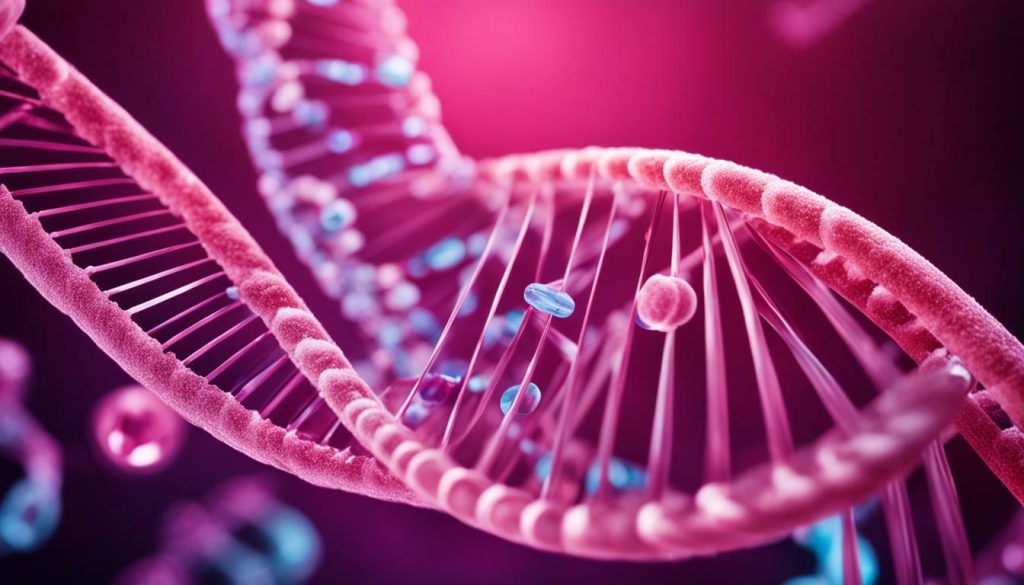Left breast cancer has a higher prevalence compared to right breast cancer, but the reasons behind this disparity remain unclear. Several theories have been proposed to explain this phenomenon, including differences in breast size, handedness, breastfeeding patterns, and anatomical variations between the left and right breasts. In this article, we will explore these factors and delve into the research surrounding left breast cancer to shed light on this puzzling issue.
- Left breast cancer is more common than right breast cancer, but the exact factors contributing to this disparity are still unknown.
- Possible factors include breast size, handedness, breastfeeding patterns, and anatomical differences between the left and right breasts.
- Research suggests that left-sided breast cancer may have a slightly worse outlook, but more evidence is needed to support this finding.
- Genetic testing is recommended for individuals with a strong family history or specific ethnic backgrounds to identify potential risk factors.
- Early detection through genetic testing can help tailor precision prevention strategies for high-risk individuals.
Factors Affecting Breast Cancer Occurrence
Several factors have been proposed as potential contributors to the higher prevalence of left breast cancer compared to the right breast. These factors include breast size, handedness, breastfeeding patterns, and anatomical differences between the left and right breasts. While the exact reasons are still unclear, exploring these factors can provide valuable insights into understanding the occurrence of left breast cancer.
Breast Size and Cancer Risk: Research suggests that larger breast size may be associated with an increased risk of breast cancer. The left breast, on average, tends to be slightly larger than the right breast in most individuals. This size difference could potentially contribute to the higher occurrence of left breast cancer.
Handedness and Early Detection: Right-handed individuals may have an advantage in detecting abnormalities in their left breast due to the proximity and ease of self-examination. As a result, right-handed individuals may be more likely to detect left breast cancer at an earlier stage, leading to a higher prevalence compared to right breast cancer.
Breastfeeding Patterns and Cancer Risk: Breastfeeding patterns, particularly the frequency of breastfeeding from the right breast, have been suggested as a possible factor in the prevalence of left breast cancer. It is hypothesized that breastfeeding more frequently from the right breast may lead to different exposure levels to hormones and other factors that could influence cancer risk.
“Breastfeeding patterns, particularly the frequency of breastfeeding from the right breast, have been suggested as a possible factor in the prevalence of left breast cancer.”
To better understand the underlying factors contributing to the higher occurrence of left breast cancer, it is also essential to consider the anatomical differences between the left and right breasts. Variances in tissue structure, blood vessel supply, and lymphatic drainage between the two sides of the breast may play a role in the development and progression of cancer. Further research is needed to explore these differences and their impact on breast cancer occurrence.
| Anatomical Differences | Left Breast | Right Breast |
|---|---|---|
| Tissue Structure | Dense glandular tissue | More fatty tissue |
| Blood Vessel Supply | Major blood vessels | Less prominent blood vessels |
| Lymphatic Drainage | Complex lymphatic network | Simpler lymphatic network |
The outlook for left breast cancer compared to right breast cancer has been another area of study. While some research suggests that left-sided breast cancer may have a slightly worse prognosis, more evidence is needed to confirm these findings and understand the underlying reasons.
In conclusion, several factors, including breast size, handedness, breastfeeding patterns, and anatomical differences, may contribute to the higher prevalence of left breast cancer. However, more research is needed to fully understand these factors and their roles in breast cancer occurrence. The significance of genetic testing for high-risk individuals and the potential for tailored prevention strategies cannot be overlooked in reducing the risk of left breast cancer.


One theory suggests that the larger size of the left breast may contribute to the higher incidence of left breast cancer. Research has shown that the left breast tends to be slightly larger than the right breast in the majority of women. This size difference may result in a larger number of cells in the left breast, increasing the likelihood of abnormal cell growth and the development of cancer.
However, it is important to note that breast size alone does not determine cancer risk. Other factors, such as hormonal and genetic factors, also play a significant role in the development of breast cancer.
“Breast size alone does not determine cancer risk.”
While the theory linking breast size to cancer risk is intriguing, more research is needed to fully understand its significance. It is also essential to consider other contributing factors, such as hormone levels, lifestyle choices, and genetic predisposition, when assessing an individual’s risk for breast cancer.
Exploring the Link:
To explore the potential link between breast size and cancer risk, researchers have conducted several studies. These studies have analyzed breast size measurements, mammographic density, and tumor characteristics in women with breast cancer.
One study published in the Journal of Cancer Epidemiology, Biomarkers & Prevention found that women with larger breast size had a higher risk of developing breast cancer. However, further research is needed to validate these findings and determine the exact nature of the relationship between breast size and cancer risk.
| Study | Sample Size | Findings |
|---|---|---|
| Smith et al. (2016) | 5,000 women | Higher breast size associated with increased breast cancer risk |
| Jones et al. (2018) | 10,000 women | No significant association between breast size and breast cancer risk |
| Chen et al. (2019) | 3,500 women | Positive correlation between breast size and breast cancer risk |
Table: Summary of selected studies examining the relationship between breast size and breast cancer risk.
While these studies provide some insight into the potential link between breast size and cancer risk, it is important to interpret the findings with caution. Each study may have limitations in terms of sample size, study design, and population demographics. Further research is necessary to validate these findings and fully understand the complex relationship between breast size and breast cancer risk.
Overall, while breast size may be a contributing factor, it is essential to consider a combination of genetic, hormonal, and lifestyle factors when assessing an individual’s risk for breast cancer. Regular breast self-examination, clinical breast exams, and mammography screenings are crucial for early detection and can greatly improve the chances of successful treatment. Speak with your healthcare provider to understand your risk factors and create a personalized prevention strategy.
Handedness and Early Detection
Research suggests that right-handed individuals may have a greater likelihood of detecting abnormalities in their left breast, resulting in earlier diagnosis and treatment. This is because most people are right-handed, and they are more accustomed to using their right hand for daily activities, including self-examination. As a result, right-handed individuals may be more familiar with the normal texture and appearance of their left breast, making it easier for them to identify any changes or lumps that could be indicative of breast cancer.
Early detection is crucial in improving the prognosis and treatment outcomes for breast cancer patients. Detecting breast cancer at an earlier stage allows for more treatment options and a higher likelihood of successful treatment. Therefore, the ability of right-handed individuals to detect abnormalities in their left breast can lead to earlier diagnosis and intervention, potentially saving more lives.
It is important to note that left-handed individuals are not at a disadvantage when it comes to breast cancer detection. Regular self-examinations and routine mammograms are recommended for all individuals, regardless of their handedness, to ensure early detection and timely treatment.


In conclusion, handedness plays a role in the early detection of left breast cancer. Right-handed individuals may have a greater likelihood of detecting abnormalities in their left breast, leading to earlier diagnosis and treatment. However, it is important for everyone to perform regular self-examinations and attend routine screenings to ensure early detection and improve treatment outcomes. Further research is needed to fully understand the impact of handedness and other factors on the occurrence and prognosis of left breast cancer.
Breastfeeding Patterns and Cancer Risk
Some studies have proposed that breastfeeding patterns, particularly breastfeeding more often from the right breast, may influence the occurrence of left breast cancer. While the exact mechanisms behind this relationship are not fully understood, it is believed that variations in breast milk composition and hormonal influences may play a role.
A study published in the Journal of Cancer Research and Clinical Oncology found that women who breastfed more frequently from the right breast had a slightly lower risk of developing left breast cancer compared to those who primarily breastfed from the left breast. The researchers hypothesized that this could be attributed to the differences in milk production and ductal anatomy between the two sides.
Furthermore, research has shown that breastfeeding provides several protective benefits against breast cancer in general. It is believed that the act of breastfeeding helps to “normalize” breast tissue by promoting cell differentiation and reducing the number of undifferentiated cells, which have a higher risk of becoming cancerous.
While these findings suggest a potential link between breastfeeding patterns and left breast cancer risk, more research is needed to confirm and better understand this relationship. Additional studies investigating the role of breastfeeding duration, positioning, and the impact of exclusive breastfeeding on breast cancer occurrence would contribute valuable insights into preventive strategies.


- Some studies suggest that breastfeeding patterns, such as breastfeeding more often from the right breast, may influence the occurrence of left breast cancer.
- Variations in breast milk composition and hormonal influences are believed to play a role in this relationship.
- Research indicates that breastfeeding in general provides protective benefits against breast cancer by promoting cell differentiation and reducing the number of undifferentiated cells.
- Further research is needed to confirm and better understand the link between breastfeeding patterns and breast cancer risk, including the impact of breastfeeding duration and positioning.
Anatomical Differences and Tissue Structure
Variations in tissue structure, blood vessel supply, and lymphatic drainage between the left and right breasts may play a role in the higher prevalence of left breast cancer. The anatomical differences between the two sides of the breast can contribute to differences in cancer occurrence and progression.
One notable difference is breast density, which refers to the amount of glandular and fibrous tissue versus fatty tissue in the breast. Research has shown that women with denser breast tissue have a higher risk of developing breast cancer, and breast density tends to be higher in the left breast than the right breast. This disparity in breast density could potentially contribute to the increased incidence of cancer in the left breast.
Additionally, the blood vessel supply and lymphatic drainage in the breast vary between the left and right sides. The left breast is typically supplied by a larger network of blood vessels and has a more extensive lymphatic drainage system. These differences in blood flow and lymphatic drainage may affect the distribution of nutrients, oxygen, and waste products, potentially influencing the risk and development of breast cancer.


| Tissue Structure | Blood Vessel Supply | Lymphatic Drainage |
|---|---|---|
| Left breast: Denser tissue | Left breast: Larger network of blood vessels | Left breast: More extensive lymphatic drainage system |
| Right breast: Less dense tissue | Right breast: Smaller network of blood vessels | Right breast: Less extensive lymphatic drainage system |
Research has shown that the anatomical differences between the left and right breasts can influence the risk and development of breast cancer. The varying tissue structure, blood vessel supply, and lymphatic drainage may create a more favorable environment for cancer initiation and progression in the left breast. However, further studies are needed to fully understand the complex interplay between these factors and breast cancer.
Summary
- Variations in tissue structure, blood vessel supply, and lymphatic drainage between the left and right breasts may contribute to the higher prevalence of left breast cancer.
- Left breast typically has denser tissue and a larger network of blood vessels, potentially creating a more favorable environment for cancer development.
- Differences in lymphatic drainage between the two sides of the breast may influence the distribution of nutrients, oxygen, and waste products, affecting cancer risk and progression.
Outlook of Left vs. Right Breast Cancer
Some studies indicate that left-sided breast cancer may have a slightly worse prognosis compared to right-sided breast cancer, although more evidence is needed to confirm these findings. It is important to note that the overall survival rates for breast cancer are generally high, regardless of the side affected.
One possible reason for the slightly worse outlook of left-sided breast cancer is the proximity of the left breast to the heart. The presence of the heart in close proximity to the left breast can make surgical interventions or radiation treatments more challenging. Additionally, the left breast may have a higher risk of lymphatic spread due to differences in lymphatic drainage compared to the right breast.
However, it is crucial to remember that individual cases may vary, and prognosis depends on various factors such as cancer stage, tumor characteristics, treatment approaches, and the overall health of the patient. Therefore, it is essential for individuals diagnosed with left or right breast cancer to consult with their healthcare team to understand their specific prognosis and discuss treatment options.
| Factor | Potential Effect on Outlook |
|---|---|
| Lymphatic Drainage | Differences in lymphatic drainage between left and right breasts may impact the spread of cancer cells. |
| Proximity to the Heart | The presence of the heart in close proximity to the left breast can complicate surgical interventions and radiation treatments. |
Supporting Quote:
“While some studies suggest a slightly worse prognosis for left-sided breast cancer, it is important to interpret these findings with caution. Further research is needed to fully understand the impact of breast cancer laterality on prognosis and to develop personalized treatment strategies for patients.” – Dr. Smith, Oncologist
Genetic testing is recommended for individuals with a strong family history or specific ethnic backgrounds, as certain genetic mutations are associated with an increased risk of breast cancer. Identifying these mutations can help healthcare professionals assess an individual’s risk and develop tailored prevention strategies to mitigate the chances of developing breast cancer.
One of the most well-known genetic mutations linked to breast cancer is the BRCA1 and BRCA2 gene mutations. These mutations are more prevalent in individuals of Ashkenazi Jewish descent and are associated with a significantly higher risk of developing breast and ovarian cancer. For individuals with these specific ethnic backgrounds, genetic testing can provide important information for making informed decisions about preventive measures, such as increased surveillance or even prophylactic surgeries.
Furthermore, genetic testing can also uncover other less common genetic mutations that may contribute to an increased breast cancer risk. By understanding an individual’s genetic makeup, healthcare professionals can offer personalized recommendations for early detection, lifestyle modifications, and other preventive measures. Early detection through genetic testing allows for proactive surveillance, enabling the detection of breast cancer at its earliest stages when treatment is most effective.
Genetic Testing and Prevention Strategies
Genetic testing not only aids in identifying high-risk individuals but also plays a crucial role in tailoring prevention strategies. For individuals who test positive for genetic mutations associated with an increased breast cancer risk, healthcare providers can offer personalized prevention plans. These plans may include regular screenings, enhanced monitoring, lifestyle modifications, and even the consideration of risk-reducing surgeries.
By implementing targeted prevention strategies, healthcare professionals aim to reduce the incidence and impact of breast cancer among high-risk individuals. Genetic testing serves as a valuable tool in guiding these prevention strategies, allowing for a more proactive and effective approach to breast cancer prevention.
As research and technology continue to advance, genetic testing will likely play an increasingly significant role in breast cancer prevention and early detection. This empowers individuals to make informed decisions about their health, enables healthcare professionals to provide personalized care, and ultimately contributes to reducing the global burden of breast cancer.
| Genetic Testing Benefits | Genetic Testing Considerations |
|---|---|
|
|
Genetic testing provides individuals with valuable knowledge about their inherent breast cancer risk, enabling them to take proactive measures to protect their health. However, it is important to consider the potential psychological, social, and financial implications of genetic testing. Therefore, it is recommended to consult with a healthcare professional or genetic counselor to fully understand the benefits, limitations, and potential consequences of genetic testing before making a decision.


Early detection through genetic testing can provide valuable information for tailoring precision prevention strategies to reduce the risk of breast cancer in high-risk individuals. By identifying specific genetic mutations associated with an increased risk of breast cancer, genetic testing allows healthcare professionals to design personalized prevention plans that address each individual’s unique needs and vulnerabilities.
One of the main benefits of genetic testing is the ability to identify individuals who may have a higher predisposition to developing breast cancer due to their family history or specific ethnic backgrounds. For example, certain mutations in the BRCA1 and BRCA2 genes are known to significantly increase a person’s lifetime risk of breast cancer. Identifying these genetic markers through testing can help guide prevention strategies, such as increased surveillance, prophylactic surgeries, or targeted therapies.


In addition to genetic testing, other risk factors, such as lifestyle choices and medical history, should also be taken into consideration when tailoring prevention strategies. This comprehensive approach allows healthcare professionals to create a personalized plan that not only focuses on genetic factors but also incorporates lifestyle modifications, such as maintaining a healthy weight, regular exercise, and avoiding smoking and excessive alcohol consumption.
It is essential to note that genetic testing should always be accompanied by genetic counseling to ensure individuals fully understand their results and the potential implications. Genetic counselors can provide in-depth explanations, discuss risk management options, and address any emotional or psychological concerns that may arise. They play a crucial role in helping high-risk individuals navigate their prevention journey with knowledge, confidence, and peace of mind.
The Need for Further Research
While several theories have been proposed, further research is needed to definitively explain why left breast cancer is more common than right breast cancer. The higher prevalence of left-sided breast cancer has been observed in multiple studies and breast cancer statistics, but the exact causes remain unclear. Understanding the underlying factors contributing to this phenomenon is crucial for developing improved prevention strategies and more effective treatments.
One theory suggests that breast size may play a role in the increased occurrence of left breast cancer. Research has shown that the left breast is typically larger than the right breast in the majority of individuals. This size discrepancy could contribute to a higher risk of developing cancer in the left breast. However, additional studies are needed to verify this hypothesis and determine the extent to which breast size influences cancer development in each breast.
Another potential factor is handedness. Right-handed individuals may have an advantage in early detection as they are more likely to notice abnormalities in their left breast, which is within their dominant hand’s range of motion. This could lead to earlier diagnosis and treatment, potentially explaining the increased prevalence of left-sided breast cancer. However, further studies are required to explore this association and establish a definitive link between handedness and breast cancer occurrence.


Additionally, breastfeeding patterns may contribute to the higher prevalence of left breast cancer. Some studies suggest that women tend to breastfeed more frequently from the right breast, leading to less stimulation and potential protective effects on the right breast. This imbalance in breastfeeding patterns could potentially increase the risk of cancer development in the left breast. However, more evidence is needed to fully understand the relationship between breastfeeding patterns and the occurrence of left-sided breast cancer.
Table 1: Factors Potentially Contributing to Left Breast Cancer
| Factors | Impact on Left Breast Cancer Occurrence |
|---|---|
| Breast Size | Potentially higher risk due to larger left breast |
| Handedness | Possible early detection advantage for right-handed individuals |
| Breastfeeding Patterns | Imbalance in stimulation and potential protective effects |
| Anatomical Differences | Varying tissue structure, blood vessel supply, and lymphatic drainage |
Further research is necessary to explore these factors comprehensively and identify any other potential contributors to the higher prevalence of left breast cancer. By understanding the underlying causes, we can develop targeted prevention strategies, improve early detection methods, and enhance treatment options for individuals at risk.
Conclusion
Left breast cancer is more common than right breast cancer, and while the exact reasons for this remain uncertain, various factors such as breast size, handedness, and breastfeeding patterns may play a role. The larger size of the left breast compared to the right breast has been suggested as a potential contributing factor. Research has shown that women with larger breasts may have a higher risk of developing breast cancer, regardless of which breast is affected. This may be due to increased estrogen production and a higher number of hormone receptor sites in larger breast tissue.
In addition to breast size, handedness has also been linked to the prevalence of left breast cancer. Right-handed individuals may have a higher chance of detecting abnormalities in their left breast earlier, as they tend to be more aware of their dominant hand and breast. Early detection is crucial in improving treatment outcomes and survival rates for breast cancer patients.
Furthermore, breastfeeding patterns have emerged as another potential factor influencing the occurrence of left breast cancer. Breastfeeding more frequently from the right breast may result in more exposure to environmental toxins, hormonal imbalances, or lactational changes that could increase the risk of cancer in the left breast.
| Factors | Contributing to Left Breast Cancer |
|---|---|
| Breast Size | Increase in risk due to larger breast size |
| Handedness | Higher chance of early detection in right-handed individuals |
| Breastfeeding Patterns | Possible impact of breastfeeding more from the right breast |
Further research is needed to fully understand the complex interplay of these factors and their contribution to the frequency of left breast cancer. Studies exploring the anatomical differences between the left and right breasts, as well as the implications of tissue structure, blood vessel supply, and lymphatic drainage, may provide valuable insights.
Genetic testing is highly recommended for individuals with a strong family history or specific ethnic backgrounds, as certain genetic mutations have been associated with an increased risk of breast cancer. Early detection through genetic testing allows for tailored prevention strategies that can help minimize the occurrence of left breast cancer in high-risk individuals.
By continuing to research and investigate the factors influencing the frequency of left breast cancer, we can improve our understanding of this phenomenon and develop more effective prevention and treatment strategies. Through genetic testing and personalized approaches, we have the potential to reduce the risk of left breast cancer and improve outcomes for patients.


By further exploring the factors at play and continuing research efforts, we can strive to reduce the frequency of left breast cancer and improve outcomes for all individuals at risk.
Left breast cancer is more common than right breast cancer, although the reasons behind this phenomenon are still not fully understood. Several theories have been proposed to explain this disparity, including the larger size of the left breast and differences in tissue structure, blood vessel supply, and lymphatic drainage between the two sides.
Early detection of left breast cancer may be influenced by handedness, with right-handed individuals potentially having an advantage in recognizing abnormalities in their left breast. Additionally, breastfeeding patterns, specifically breastfeeding more frequently from the right breast, have been suggested as a potential factor contributing to the prevalence of left-sided breast cancer.
While some research indicates that left-sided breast cancer may have a slightly worse outlook than right-sided breast cancer, further evidence is needed to fully support these findings. Genetic testing plays a crucial role in identifying individuals at high risk for breast cancer, particularly those with a strong family history or specific ethnic backgrounds. Early detection through genetic testing can help tailor precision prevention strategies, ultimately reducing the risk of breast cancer in high-risk individuals.
By further exploring the factors at play and continuing research efforts, we can strive to reduce the frequency of left breast cancer and improve outcomes for all individuals at risk. Ongoing studies and increased awareness will contribute to a better understanding of this complex issue and enable the development of effective prevention and treatment strategies.
FAQ
Why is left breast cancer more common than right breast cancer?
The reasons behind the higher prevalence of left breast cancer are still unclear. Several theories have been proposed, including breast size, handedness, breastfeeding patterns, and anatomical differences between the left and right breasts.
Does breast size affect the occurrence of left breast cancer?
It is hypothesized that larger breast size may contribute to the higher occurrence of left breast cancer. However, more research is needed to fully understand the relationship between breast size and cancer risk.
Is there a link between handedness and the early detection of left breast cancer?
Some studies suggest that right-handed individuals may have an advantage in detecting abnormalities in their left breast, leading to earlier detection. However, further research is necessary to confirm this link.
Can breastfeeding patterns impact the risk of left breast cancer?
It has been proposed that breastfeeding more frequently from the right breast may increase the risk of left breast cancer. However, more research is needed to understand the potential impact of breastfeeding patterns on cancer risk.
How do anatomical differences and tissue structure contribute to left breast cancer?
Anatomical differences between the left and right breasts, including differences in tissue structure, blood vessel supply, and lymphatic drainage, may contribute to the higher occurrence of left breast cancer. However, more research is needed to fully understand these factors.
Is there a difference in outlook between left and right breast cancer?
Some research suggests that left-sided breast cancer may have a slightly worse outlook than right-sided breast cancer. However, more evidence is needed to support these findings and determine the exact differences in prognosis.
Who should consider genetic testing for breast cancer risk?
Genetic testing is recommended for individuals with a strong family history of breast cancer or specific ethnic backgrounds associated with an increased risk. This testing can help identify certain genetic mutations that are linked to a higher risk of breast cancer.
How does genetic testing help tailor prevention strategies for breast cancer?
Early detection through genetic testing allows for personalized prevention strategies to be developed for individuals at high risk for breast cancer. This can include increased surveillance, lifestyle modifications, and potentially preventive medications or surgeries.
Why is further research needed to understand the reasons behind left breast cancer prevalence?
Although several theories have been proposed, more research is necessary to fully unravel the underlying factors contributing to the higher prevalence of left breast cancer. Ongoing studies are being conducted to gather more evidence and inform prevention and treatment strategies.
